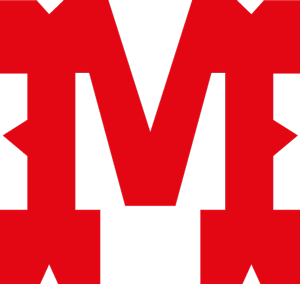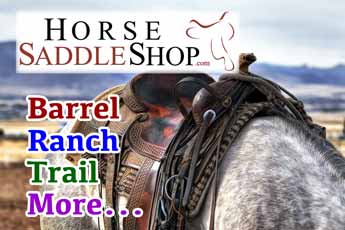How To Tell A Boy Cow From A Girl Cow
There seems to be a lot of confusion and misinformation out there about how to tell a boy cow from a girl cow (there's no such thing as a "boy cow," by the way).
Here at CowboyWay.com we've known a lot of people who didn't know how to tell the difference between a bull, steer, cow or heifer, and a fair percentage of these folks even had close ties to the farming or ranching industries.
Fortunately, understanding and recognizing the differences between sexes in cattle isn't difficult. In the text and photos below we describe how to tell the difference between male and female animals in the biological subfamily Bovinae (commonly called bovines) which includes the species cattle.
In other words, how to tell a boy cow from a girl cow. (And we repeat: There's no such thing as a "boy cow." Trust us.)
The Boys: What You Call Them
In cattle, males (boys) are either bulls, steers, or oxen. We can also use the word "calf" for a boy because in bovines it's a word that is used for both young males and females.
- Bull - A bull is an "intact" male, which is a male that has testicles. Since a bull has testicles (and assuming he is otherwise healthy) he can sire offspring. A bull's testicles are contained in a pouch called called the scrotum, which is visible between the hind legs.
- Steer - A steer is a male that was born a bull but has had his testicles removed before reaching sexual maturity. A steer cannot sire offspring. Because the testicles have been removed the pouch that contained them, the scrotum, is shrunken and (usually) can't be seen when the animal is in a normal standing position.
- Ox - An ox is a male that was born a bull but has had his testicles removed after reaching sexual maturity. An ox cannot sire offspring. Because the testicles have been removed the pouch that contained them, the scrotum, is shrunken and (usually) can't be seen when the animal is in a normal standing position.
- Calf - The word "calf" for cattle is similar to the word "baby" in humans: It is gender-neutral and can be used to describe a young male or female. It is commonly used to describe cattle less than a year old.
Note: Since steers are more common than oxen (the plural of ox), and for the simplicity of the remainder of this article, we will refer to all castrated bulls as steers.
Bulls and steers both have a penis and a sheath. Since they both have a penis, bulls and steers both have a sheath, which is the external pouch that contains the penis. The sheath is located on the underneath side of a bull or steer's belly. Depending on the individual the sheath might be large and very noticeable, or (particularly in steers) barely visible.
Bulls and steers both have an anus. The anus is the outlet of the rectum. In both bulls and steers the anus is located underneath the tail. (Females also have an anus underneath the tail, but they also have the added presence of a vulva.) Depending on how the animal is holding its tail, you may, or may not, be able to see the anus.
The Boys: Let's Have A Look
When determining if a male bovine is a bull or a steer, there are two main places to look: Underneath the belly and underneath the tail.
Underneath The Belly
Below is a look underneath the belly of a bovine.
- The presence of the sheath lets us know that this is male.
- The additional presence of the testicles, which are contained in an external pouch called the scrotum, lets us know that this a bull (as opposed to a steer).
Note: In some cases depending on how and when a steer was castrated there might be a small amount of the scrotum still visible. However, in these instances it is quite small and "dried up" looking, probably difficult to see, and does not resemble the large, healthy, bull scrotum shown here.
Below: A look underneath the belly of a bull.
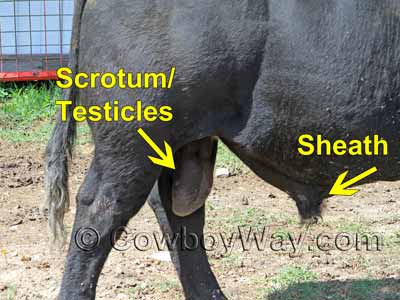
Below is a look underneath the belly of a young calf (remember, the word "calf" is gender-neutral and is used to describe both young males and females).
- We know by the presence of the sheath that it's a male.
- However, since we cannot see between the hind legs to know whether or not he has testicles, we can't tell if it's a bull or a steer.
Note: On a calf this size the testicles, if present, would be contained in a comparatively small scrotum and would be more difficult to see than on a mature bull.
Below: A young male calf.
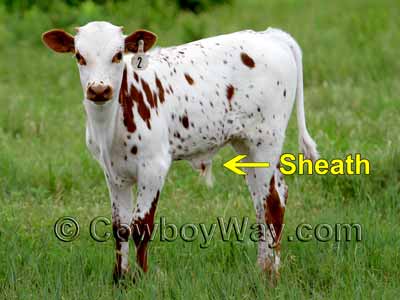
Underneath The Tail
Below is a look underneath the tail of a bovine.
- The presence of the anus without the additional presence of a vulva lets us know this is a male.
- However, since we cannot see between the hind legs to know whether or not he has testicles, we can't tell if it's a bull or a steer.
Below: A look underneath the tail of a male bovine.
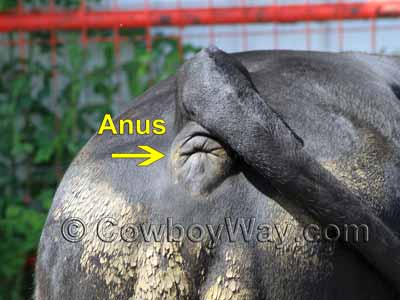
The Girls: What You Call Them
In cattle, girls are either heifers or cows. We can also use the word "calf" for a girl because in bovines it's a word that is used for both young females and males.
- Heifer - A young female. When a heifer matures she is called a cow.
- Cow - A mature female.
- Calf - The word "calf" for cattle is similar to the word "baby" in humans: It is gender-neutral and can be used to describe a young female or male. It is commonly used to describe cattle less than a year old.
Note: Like we mentioned above a heifer is a young female while a cow is a mature female. For the simplicity of the remainder of this article, we will usually refer to all females as cows.
Heifers and cows have udders and vulvas. Unlike bulls and steers, heifers and cows have udders (the mammary glands that produce milk to feed offspring) and vulvas (the external opening to the vagina and bladder). Udders are visible between a heifer or cow's hind legs. Vulvas are visible underneath the tail beneath the anus (assuming the tail isn't blocking the view).
The Girls: Let's Have A Look
When determining if a bovine is a female, there are two main places to look: Underneath the belly and underneath the tail.
Underneath The Belly
Cows look different underneath the belly when compared to bulls and steers. Instead of a scrotum (if it's a bull) and/or a sheath (for both bulls and steers) cows have an udder.
Below is a look underneath the belly of a bovine.
- The presence of the udder between the back legs lets us know that this is a cow. This particular udder is plump and full-looking because it is full of milk. An udder might look less full than this, or it might even be empty, but it is still an udder.
Below: A look at the udder on a cow.
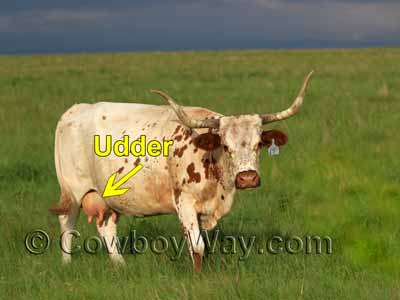
Underneath The Tail
Cows look different underneath the tail than bulls and steers. While cows, bulls, and steers all have an anus, cows have the added presence of a vulva beneath the anus.
Below: A look underneath the tail of a cow.
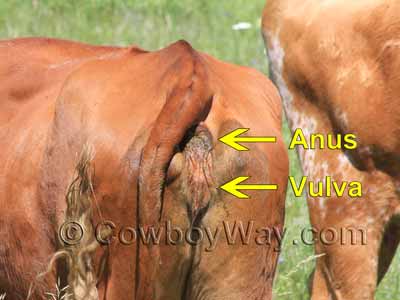
Bathroom Basics For Telling Boys From Girls:
Where Does The Urine Come
Out?
Urine exits the body of male and female bovines in different places.
- Urine exits a bull or steer through the sheath, which is underneath the belly.
- Urine exits a heifer or cow through the vulva, which is underneath the tail.
So, if you see a bovine urinating, you can tell if it's a boy or girl according to where the urine is exiting the body. (If it's a boy, though, this alone won't tell you if it's a bull or steer. To know that you'll need a closer look to see if there are testicles present.)
How NOT To Tell A Boy From A Girl #1: Navels Aren't Sheaths
Both both male and female bovines have a navel, which is the place on the underneath side of their belly where the umbilical cord was attached before they were born. In both males and females the navel is often quite small and in many cases, for most practical purposes, is not visible.
Sometimes, however, navels in both males and females are larger and therefore easily seen.
- When a male has a large, visible, navel it more-or-less blends in with the sheath, which means he's a boy that still looks like a boy.
- However, when a female (heifer or cow) has a large, visible, navel some people mistake it for a sheath.
A visible navel in a cow might be small and barely noticeable, or quite large.
Below: A look at a small but visible navel underneath the belly of a cow.
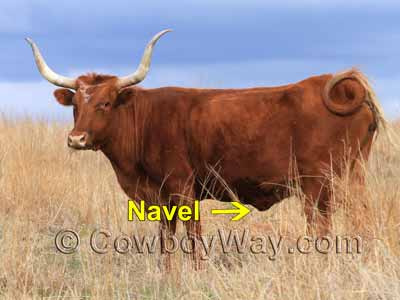
To help distinguish a navel from a sheath it's handy to know that the bottom of a sheath ends in an opening that often has extra-long hairs hanging from it (depending on the individual there may be a few extra-long hairs or a lot).
A navel, on the other hand, does not have an opening or extra-long hairs, and in general has a smoother appearance along its bottom.
Below: The back three-fourths or so of a Charolais bull showing his hairy sheath.
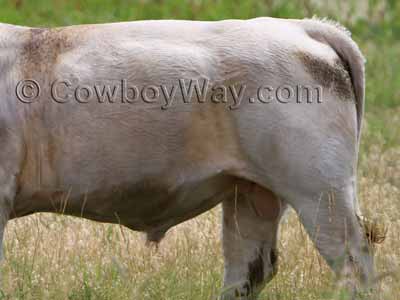
How NOT To Tell A Boy From A Girl #2: Horns Don't Matter
Both male and female bovines can have horns. Some people are under the mistaken impression that only males can have them, but in cattle (as well as some other species) both males and females can have horns.
It's worth mentioning that while both males and females can have horns that doesn't mean they have to. Some folks incorrectly believe, for example, that all bulls have horns. This isn't true. A bull (or steer or cow, for that matter) may, or may not, have horns.
Below: A cow with horns. (Whether or not this is a cow can't actually be discerned from the photo, but she was ours for several years, and we can vouch that she was definitely a cow.)
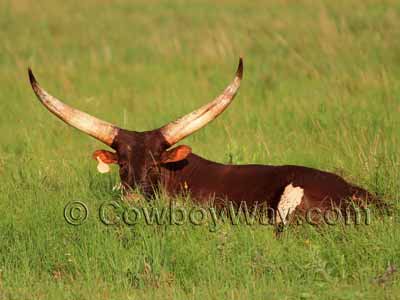
Parting Thoughts
In mature bovines there can be, and usually is, a noticeable overall difference in the appearance between males and females. The mature males (and in particular the bulls) tend to be larger than the females of the same breed, and exhibit a more muscular appearance.
Mature females, on the other hand, tend to be smaller and may have a more visible bone structure due to being less heavily muscled.
The differences in appearance between male and female bovines is sometimes described as a more "masculine" or "feminine" appearance. In mature animals these differences are sometimes obvious even to casual observers.
However, in younger animals these differences typically haven't developed yet and other methods for telling boys from girls (such as looking underneath the belly and/or the tail) must be used.
Below: While we can't see all of the animal, we can guess by the masculine appearance, including the heavily-muscled neck and shoulders, that this is a bull (and it is). This bull is two years old and will get even more heavily muscled as he matures.
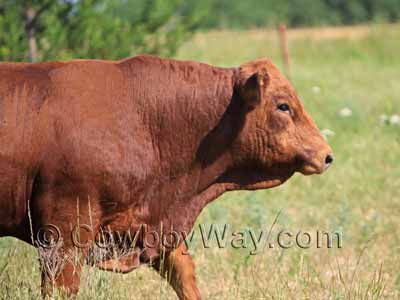
How To...
… Care For Your Felt Cowboy Hat
… Care For Your Saddle Pad Or Blanket
… Close A Gate With A Chain Latch
… Estimate Cattle Age By Their Teeth
… Fishtail Braid Your Horse's Tail
… Make A Bridle Rack Out Of Tin Cans
… Make A Collapsible Wood Saddle Rack
… Make A Flag Boot Out Of A Horn
… Make Homemade Hoof Conditioner
… Make Homemade Horse Fly Spray
… Measure A Western Saddle Seat
… Put A Horn Knot On Your Rope
… Put A Speed Burner On A Honda
… Recognize Common Horse Colors
… Recognize Common Horse Face Markings
… Stop A Saddle From Squeaking
… Tell A Boy Cow From A Girl Cow
… Tell A Horse Skull From A Cow Skull
… Tie A Stopper Knot
Tie a stopper knot for the end of a rope, or a metal, rawhide, or plastic honda
… Tie A Stopper Knot For A Honda
Tie a stopper knot for a tied honda
… Understand Leather / Hide Thickness
… Weigh A Horse and Optimize Rider Weight
… Wrap A Saddle Horn With Rubber
You Might Also Like...
